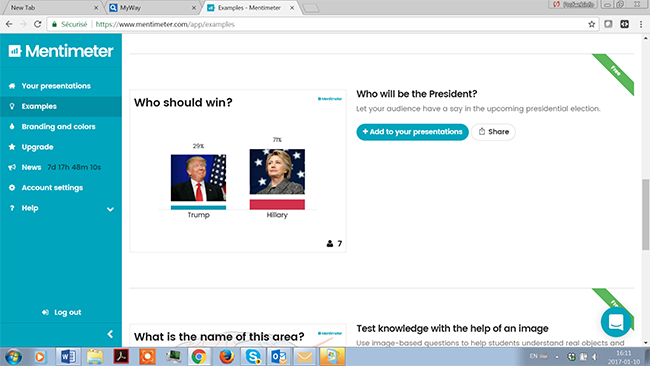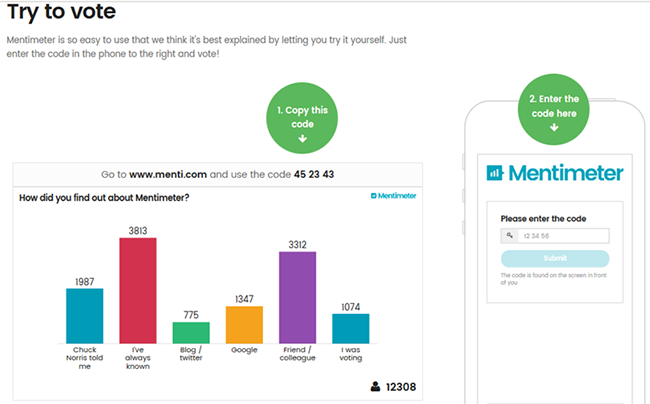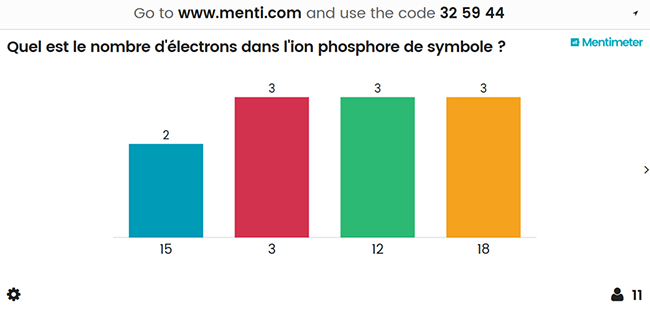The Smartphone in Class: The Potential of Mentimeter
An enthusiast of active pedagogical approaches, I like the possibilities that technologies offer for my pedagogical practices. I will share with you my experience of a pedagogical use of cell phones in class with Mentimeter. This was a very enriching experience for my teaching in chemistry. I also gave a presentation to my colleagues during a pedagogical meeting and to my colleagues of the college network in the form of a workshop given during a thematic day offered by the ACPQ (Association des collèges privés du Québec), June 1st, 2016.
The Problem
I have just completed a class of the Chemistry of Solutions course with my students in Pure and Applied Sciences. When I conduct a quick reflective analysis on the achievement of my objectives, I am not satisfied. In fact, once again, it proves difficult to truly evaluate the past knowledge of students in the activation phase of learning. The students are shy to reply freely in class and it seems even more so when they try to give an answer.
I wondered how to bring to all of the students to freely reflect upon a question, while being able to have a true idea of their level of knowledge of the concept that was taught in order to better align my teaching.
What a coincidence! That same evening, I spoke with a friend that was taking a course from the microprogram in college teaching with Université de Montréal. He had just discovered, with his internship mentor, the use of clickers. Spontaneously, I told him that was exactly what I needed to address my pedagogical objective. Date of putting this solution to the test: the next class! Pressed to experiment with the clickers in my class, I was faced with 2 constraints:
- The college did not yet have any clickers and I needed to make a request to have them ordered.
- This option required that I bring them to each class and that I return them afterwards.
The Solution: Mentimeter
The same night, I did a quick online search to find a solution that was faster and less constraining. I discovered free online software that works exactly like the clickers, but without constraints, other than having a smartphone on hand and an internet connection. These are not a problem, as all of my students have a device and they have free access to the internet network of the college.

The homepage of the Mentimeter site.

An example of questions presented by the site Mentimeter.
In very little time, I had understood how Mentimeter works, I had created my questions and the following week, I experimented with this tool in class. In the end, I was considerably satisfied, truly above my expectations. With this application, I covered, in one single activity based on one concept:
- The activation of knowledge
- Diagnostic evaluation
- Formative evaluation
- Regulation
- Feedback
- The positive use of cellphones in class
As with clickers, all that is required is to create your questionnaire, but with Mentimeter, the students vote on their smartphones.

Inputting the access code for a questionnaire.
How to Use It?
To begin, there are 3 simple steps:
- To create questions and follow up, the teacher creates an account on Mentimenter.com, but the students do not need to create an account.
- The student enters the link www.menti.com on his/her cell phone, then the code corresponding to the question (in the case illustrated above: 452363). The student can then vote according to his/her choice.
- The teacher sees the number of votes entered. The teacher also has access to different options like hiding the choices during the vote, limiting the duration of time to vote, etc. It is also possible to choose other types of questions aside from multiple choice.
In practice, I submit questions to students before tackling a concept. After having seen the concept, I ask the students to vote again on the same question. Here are the results obtained with the participants at the workshop on techno-pedagogy with Mentimeter during a seminar with the ACPQ in 2016.

Results before tackling the concept (the symbol P3 was written on the board).

Results after having tackled with concept (the symbol P3 was written on the board).
We remark that working as a team on the atom components and their number favoured the learning of the participants. According to the second vote, the teacher draws conclusions that allow him to regulate his teaching, at the same time as the students have direct feedback on their learning.
We therefore have an activation of past knowledge, a diagnostic evaluation and a formative evaluation in one activity.
If you worry about the effects of using smart phones on your class management, you can always choose to have students vote on their computers, the principle is the same as on the smart phone. However, I noticed that the motivation and interest of my students was higher when they used their cell phones.

